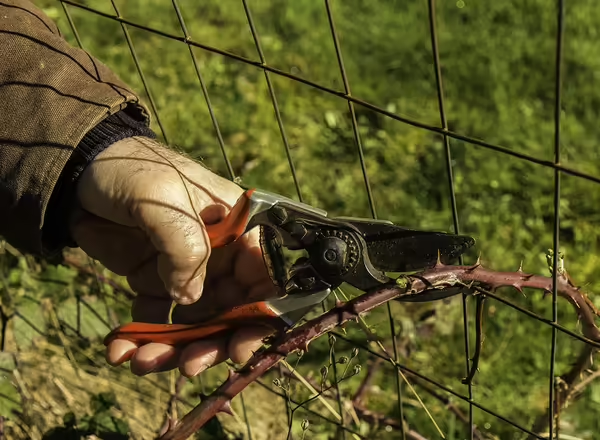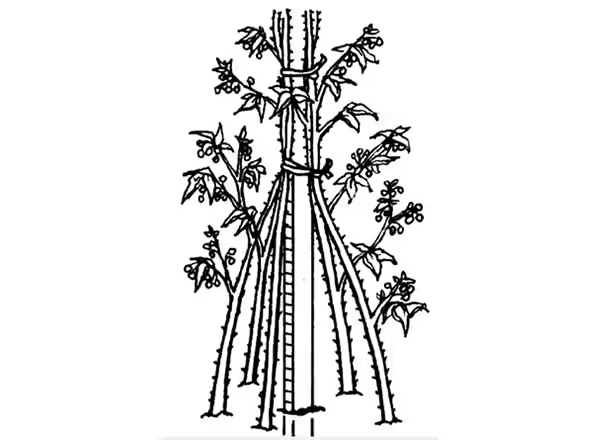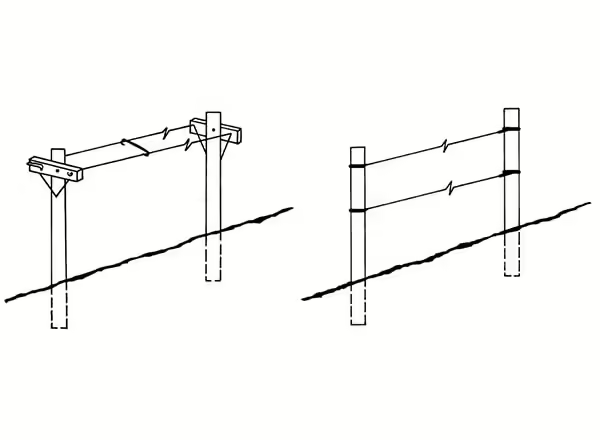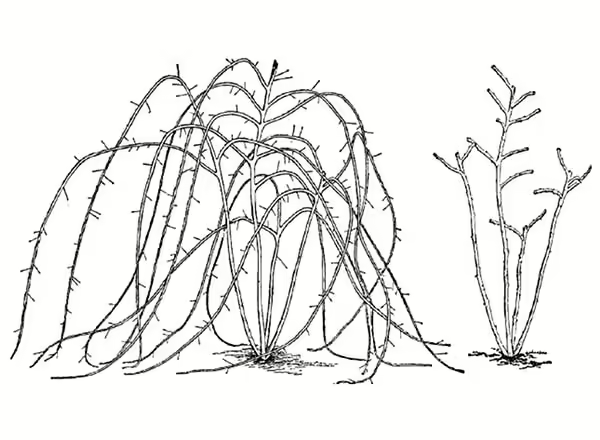To prune brambles properly, it is essential to understand their growth and fruiting habits.
Brambles bear fruit on canes that live for two years.
- The roots and crowns are perennial. All brambles send up new shoots during each growing season from the crown. The first year, these new shoots are called primocanes. Erect blackberries and red or yellow raspberries develop primocanes from both the crown and roots.
- These primocane shoots, regardless of origin, grow vigorously during the summer, initiate flower buds in the fall, overwinter, and bear fruit the following season.
- In the second season, the shoots are called floricanes. The fruit is borne on leafy shoots arising from lateral buds on the floricanes. After harvest, the floricanes gradually dry up and die. Meanwhile, new primocane shoots are developing to repeat the cycle, thus providing fruiting canes each year.
Some brambles fruit twice on the same cane. These are called everbearing, fall bearing, double cropping, or primocane flowering. At present, only red and yellow raspberries are available as primocane-bearing cultivars. The primocanes bear a crop at their tips in the fall and again the next season as floricanes further down on the canes, after which the canes die.

Variation in the development of lateral branches must be considered in order to properly prune brambles. Black raspberries, purple raspberries, and erect blackberries develop strong lateral branches when the new shoot tips are cut back early in the growing season. This characteristic is encouraged by the practice of pinching, or summer topping, which consists of snapping off or cutting with shears the top three or four inches of the new shoots (Figure M-13.). This system has no advantage for red and yellow raspberries, semi- erect blackberries, and trailing blackberries. If red or yellow raspberries are topped, weak laterals develop. These break easily and are likely to be winterkilled.
Trellises and Training of Blackberries
Although most of the brambles can be grown without support, some type of support or trellis is desirable to produce high-quality fruit. Trailing and semi-erect blackberries must be supported. Fruit on supported plants is clean, and a minimum of the crop is lost due to cane breakage by wind, cultivation, and picking. Supports also facilitate harvesting and other cultural practices and in the long run will pay for themselves. Trellised plantings can usually be kept attractive in the home landscape.

Many types of trellises and methods of training are in use by bramble growers. The following are some of the simplest methods of satisfactory trellis construction. The hill system of culture may be used for any of the bramble fruits. A single stake, 2 to 4 inches in diameter, driven into the ground, supports the plant. Five to 8 canes are tied in one or more places to the stake in the spring following dormant pruning. The plants are usually set four to 6 feet apart each way.

Wire trellising systems are more practical for large plantings. Posts for building a trellis may be either metal or wood. If wood posts are used, buy treated posts for extended usefulness. Posts should be spaced 25 to 30 feet apart in the row, with the end posts braced or anchored. A nine- to twelve-gauge galvanized wire is adequate for the trellis.
For raspberries and erect blackberries, the most common system of training is the horizontal trellis. The plants form a solid hedgerow that is kept about 18 inches wide. Each spring the canes within the row are thinned so that they are at least 6 to 12 inches apart. The canes are supported between the trellis wires and do not have to be tied when using this system. Wire clips can be used to keep the wires from spreading between the posts.
The vertical trellis is used with trailing blackberries and semi-erect thornless blackberries. This system allows excellent weed, disease, and insect control. Plants are maintained in a narrow row and are tied to the trellis wires. Harvesting of these plants is also easier when they are secured to a trellis.
These cane fruits should be pruned three times per year—in early sprint, after the harvest, and during the summer.
Summer pruning is an essential step in the production of these brambles.
- All new shoots should be pinched back three to four inches once they have grown to the desired height.
- If grown without supports, black raspberries are pinched when the shoots are about 24 inches high;
- purple raspberries and erect blackberries are pinched when they reach 30 to 36 inches.
- If the brambles are grown with supports, the shoots can grow 6 to 8inches more before pinching.
- Some of the thorny blackberry cultivars from Arkansas are strong enough to be self-supporting at heights of 4 to 5 feet. These cultivars can be pinched back when they attain a height of about 48 inches.
The pinching operation usually coincides with harvest. The plantings should be examined several times because primocanes develop over a period of several weeks.

Fruited canes of black and purple raspberries and erect blackberries should be removed after harvest. Dormant pruning is best done in the late winter to early spring before the buds begin to swell. All weak canes should be cut out at the ground level, leaving four or five of the most vigorous canes (at least one-half-inch diameter) per plant. The lateral branches on the remaining canes are thinned out and shortened. All broken, weak (usually one-fourth inch diameter or less), and dead laterals are removed. The laterals of black raspberries are shortened to 8 to 10inches of growth, or 8 to 12 buds per lateral. Purple raspberries and erect blackberries are more vigorous; thus, the laterals may be left 12 to 18 inches long, or with about 15 buds per lateral.
Erect blackberries send up root suckers in addition to the new canes that grow from the crown. If all of these have been allowed to grow during the previous season, they should be thinned out during the dormant pruning process to leave about three to four canes per linear foot of row. A better practice is to remove the excess suckers during the summer, leaving only those desired for fruiting next season. The suckers should be pulled out, if possible, since they do not regrow as quickly as those that are cut off at ground level.

These brambles are pruned twice, once in early spring and again after harvest. Pinching the new shoots as they develop is not practical and may lead to winter damage. The tips of thornless trailing blackberry canes are the first to show winter kill. Therefore, if you leave the canes unpruned as the plants go into winter, the lower part of the cane may still be alive in the spring.
Spring pruning of these brambles consists simply of selecting the best canes or cane parts that have survived the winter, tying them to a trellis, and removing damaged and diseased canes. Select the best six to eight canes. If stakes are used for support, the canes can be wrapped around the stake, tied at two or three places, and cut off to the height of the stakes. On a horizontal trellis, the canes are wound around the wires and tied. On a vertical trellis, the canes are tied to the wires without being wound. Remove all fruiting canes after harvest at ground level.